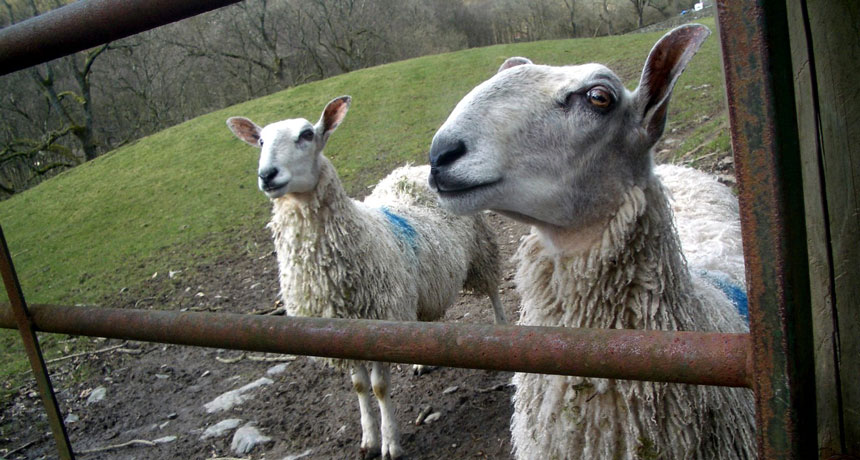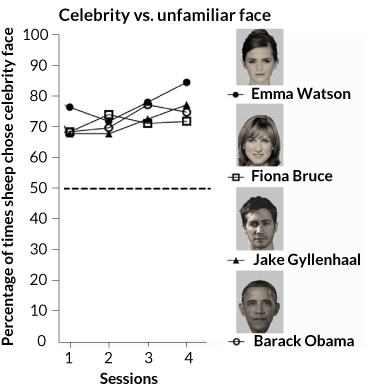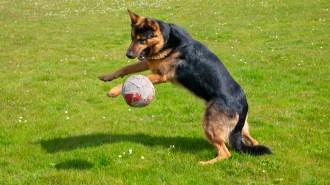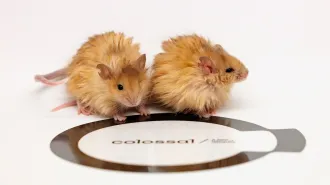
DOUBLE TAKE Scientists trained sheep to recognize pictures of celebrity faces, and showed that the animals have advanced, face-processing abilities similar to those of humans.
Kate Travis
Emma Watson, Jake Gyllenhaal, journalist Fiona Bruce and Barack Obama all walk into a sheep pen. No, this isn’t the beginning of a baaa-d joke.
By training sheep using pictures of these celebrities, researchers from the University of Cambridge discovered that the animals are able to recognize familiar faces from 2-D images. Given a choice, the sheep picked the familiar celebrity’s face over an unfamiliar face the majority of the time, the researchers report November 8 in Royal Society Open Science.
Even when a celeb’s face was slightly tilted rather than face-on, the sheep still picked the image more often than not. That means the sheep were not just memorizing images, demonstrating for the first time that sheep have advanced face-recognition capabilities similar to those of humans and other primates, say neurobiologist Jennifer Morton and her colleagues.
Sheep have been known to pick out pictures of individuals in their flock, and even familiar handlers (SN: 10/6/12, p. 20). But it’s been unclear whether the skill was real recognition or simple memorization. Sheep now join other animals, including horses, dogs, rhesus macaques and mockingbirds, that are able to distinguish between individuals of other species.
Morton and her colleagues released eight sheep one-by-one into a pen outfitted with two computer screens. A celebrity’s face would appear on one screen, while a different image appeared on the other. First, the team familiarized the sheep with the celebrities’ faces by showing the faces opposite a black screen or random objects. Picking the celebrity earned a sheep a food-pellet reward.
Next, researchers paired a celebrity mug, like Gyllenhaal’s now-familiar face, with an unfamiliar person. By the end of this experiment, the sheep chose a familiar celebrity’s face over a stranger’s face about 79 percent of the time on average.
To see if the sheep were just memorizing shapes, researchers did the same test, but with pictures in which the celebs’ heads were tilted right or left. The sheep didn’t do as well but still passed, recognizing the celebrities about 67 percent of the time on average — a drop in performance comparable to that seen in humans performing the same task.
In a final test, the sheep had to choose between a picture of one of their handlers’ faces and an unfamiliar face. On her first try, one sheep appeared taken aback by the new face in the mix. She did a double take of both faces before ultimately choosing her handler. Since the handler cares for the sheep daily, the animals were familiar with her — although they had never seen a 2-D photo of her face. Recognizing a person that is familiar from 3-D life requires “complex image processing,” the authors say, because the sheep must translate their memory of the person to a 2-D picture.
Brad Duchaine, a brain scientist at Dartmouth College, doesn’t find the sheep’s ability surprising. “My guess is that the ability of sheep to recognize human faces is a by-product of selection to discriminate between different sheep faces,” he says. “Either the human face is similar enough to the sheep face that [it] activates the sheep face-processing system, or human-face recognition relies on more general-purpose recognition systems.”
EWE AGAIN Sheep were trained to recognize celebrity faces, demonstrating that the animals can recognize a familiar human face from a 2-D image. |
Editor’s note: This story was updated November 21, 2017, to correct the percentage of sheep that recognized tilted faces.







